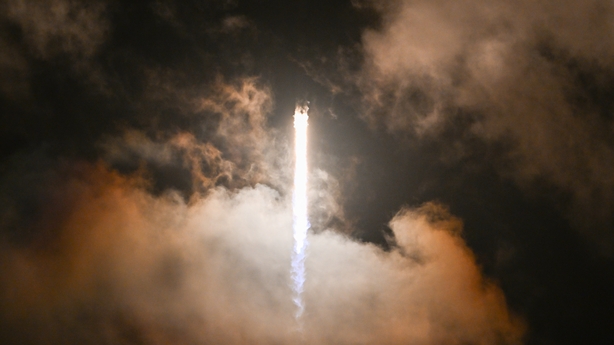SpaceX has launched its Polaris Dawn mission, a multi-day orbital expedition carrying a four-member civilian crew for the first spacewalk by non-professional astronauts.
"Liftoff of Polaris Dawn!" SpaceX said on X, alongside a photo of the rocket as it took off.
The Polaris Dawn mission launched from NASA's Kennedy Space Center in Florida at 5.23am (10.23am Irish time) after being delayed earlier due to unfavourable weather.
A four-member crew, led by Shift4 Payments CEO Jared Iscaacman, is also aiming to fly deeper into space than any other manned mission in more than half a century, reaching a peak altitude of 1,400km.
The highlight of the mission will be the first spacewalk composed entirely of non-professional astronauts, who will be wearing sleek, newly developed SpaceX extravehicular activity (EVA) suits outfitted with heads-up displays, helmet cameras, and an advanced joint mobility system.
On the first day of their mission the craft will travel so high that it will briefly enter the Van Allen radiation belt, a region teeming with high-energy charged particles that can pose health risks to humans over extended periods.
The mission had been delayed several times, initially due to a technical issue with the launch tower and since then because of weather constraints.

An attempt to launch last month was postponed hours before liftoff over a small helium leak in ground equipment on SpaceX's launchpad.
SpaceX fixed the leak, but the company's Falcon 9 was then grounded by US regulators over a booster recovery failure during an unrelated mission, further delaying the Polaris launch.
Only highly trained, well-funded government astronauts have done spacewalks in the past.
There have been roughly 270 on the International Space Station (ISS) since its creation in 2000, and 16 by Chinese astronauts on Beijing's Tiangong space station.
The Polaris Dawn spacewalk is planned for the mission's third day at 700 km in altitude and will last about 20 minutes.
SpaceX's Crew Dragon craft will slowly depressurize its entire cabin - it has no airlock like the ISS - and all four astronauts will rely on their slimmed-down, SpaceX-built spacesuits for oxygen.
The Crew Dragon capsule will not dock with the ISS, which is why the weather needs to be favorable during both the launch and splashdown phase, around six days after liftoff.
Jared, Kidd, Sarah, and Anna walking down the crew arm ahead of entering Dragon pic.twitter.com/o0HCKwFhJW
— SpaceX (@SpaceX) September 10, 2024
More than two years preparation for mission
Mr Isaacman has declined to reveal his total investment in the project, though reports suggest he paid around $200m for the SpaceX Inspiration4 mission in September 2021, the first all-civilian orbital mission.
Rounding out the team are mission pilot Scott Poteet, a retired US Air Force lieutenant colonel; mission specialist Sarah Gillis, a lead space operations engineer at SpaceX; and mission specialist and medical officer Anna Menon, also a lead space operations engineer at SpaceX.
The quartet underwent more than two years of training in preparation for the landmark mission, logging hundreds of hours on simulators as well as skydiving, centrifuge training, scuba diving, and summiting an Ecuadorian volcano.
Polaris Dawn is set to be the first of three missions under the Polaris program, a collaboration between Mr Isaacman, the founder of tech company Shift4 Payments, and SpaceX.
Also on their to-do list are testing laser-based satellite communication between the spacecraft and Starlink, SpaceX's more than 6,000-strong constellation of internet satellites, in a bid to boost space communication speeds, and conducting 36 scientific experiments.
Among these are tests with contact lenses embedded with microelectronics to continuously monitor changes in eye pressure and shape.
